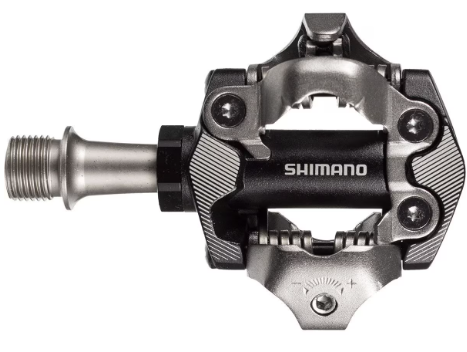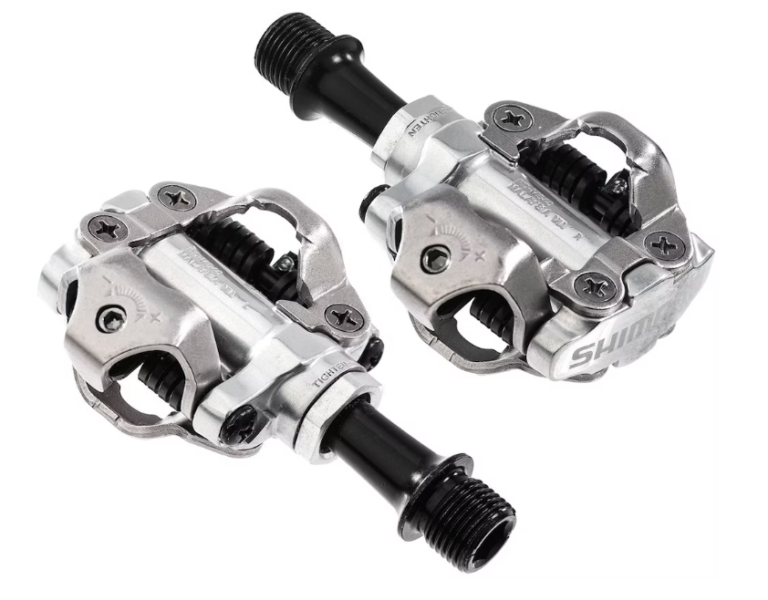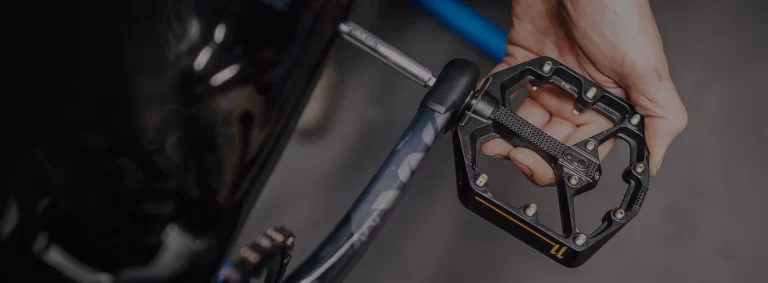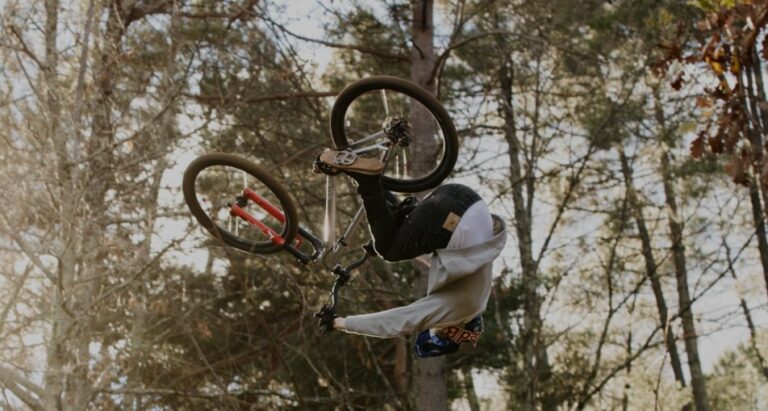Mountain Bike Pedals Buyers Guide

Key Point Summary of this Mountain Bike Pedals Buyers Guide
- My Take on Mountain Bike Pedals: Picking the right pedals is key to a great ride – I’ve learned this through many years riding mountain bikes.
- Flat Pedals: Great for starting out or downhill thrills. They’re simple, with a flat surface and grippy pins. I love them for their no-fuss foot removal, though they’re not the best for power efficiency.
- Clipless Pedals: These are my go-to for serious trail riding. They clip onto special shoes, boosting my pedaling power and control. Sure, they take some getting used to, but they’re worth it for the efficiency.
- Choosing Pedals: I look at materials – aluminum, steel, or plastic, each with its pros and cons. Grip’s crucial, especially on flats. The pedal size should fit your foot for comfort, and weight matters for those long rides.
- Maintenance and Shoes: Easy upkeep is a must for me. And for clipless, ensure they match your shoes’ cleat system.
- My Advice: Regularly check your pedals and practice with clipless if you’re new to them.
- Bottom Line: Your choice should fit your ride style and comfort. For me, it’s about the right blend of material, grip, and compatibility with my gear.
Selecting the right mountain bike pedals is essential for ensuring comfort, control, and efficiency during your rides. This Mountain Bike Pedals Buyers Guide provides detailed insights into different types of pedals and the key factors you should consider before making a purchase.
Types of Mountain Bike Pedals

Flat Pedals
- Description: These pedals have a broad, flat surface and usually feature pins or teeth to enhance grip. They don’t attach to the shoe, allowing for easy foot removal.
- Suitability: Ideal for beginners due to their simplicity, downhill riders who value quick foot release, and those who perform tricks or face frequent stops.
- Pros: User-friendly, no need for special shoes, and allows for immediate foot removal which is useful in technical terrains or during falls.
- Cons: Less effective in power transfer as feet can more easily slip off, especially in wet or muddy conditions.

Clipless Pedals
- Description: Featuring a mechanism that ‘clips’ into a cleat attached to the bottom of specific biking shoes, these pedals secure the foot in place.
- Suitability: Favored by experienced riders, especially those into cross-country and trail riding, who seek improved pedaling efficiency.
- Pros: Enhanced power transfer, increased pedaling efficiency, and better bike control. They also help maintain consistent foot positioning.
- Cons: Require practice for quick engagement and release, especially in emergency situations, and necessitate compatible cleat-system shoes.
Key Features to Consider
Material
- Pedals are manufactured from materials like aluminum, steel, or composite plastic. Aluminum offers a good balance between weight and durability, steel is highly durable but heavier, and plastic is lightweight but less durable.
Grip
- For flat pedals, grip is key. Look for models with adjustable and replaceable pins. This allows you to customize the grip based on your preference and replace pins as they wear out.
Size and Shape
- Pedal size and shape should complement your foot size for optimal support. Larger platforms are beneficial for stability and control, especially for aggressive riding or larger feet.
Weight
- Lighter pedals are generally more desirable for long rides or competitive scenarios, but ensure that weight savings do not compromise pedal strength and durability.
Bearings
- Quality bearings are crucial for smooth rotation and longevity of the pedals. Sealed bearings, although slightly heavier, provide better protection against elements like dirt and moisture.
Maintenance
- Consider how easy it is to maintain the pedals. Some pedals allow for straightforward pin replacement and bearing servicing, which can extend their lifespan and improve performance.
Compatibility with Shoes
- For clipless pedals, it’s crucial to ensure that they are compatible with your mountain biking shoes. The cleat system (like SPD, Time, or Crankbrothers) should match the shoe and pedal.
Safety and Usage Tips
- Regular maintenance is key. Inspect your pedals before each ride for any signs of wear or damage.
- For those new to clipless pedals, practice engaging and disengaging in a safe, controlled environment. Start with lower tension settings for easier release.
- Consider the terrain and type of riding you do when choosing pedal type. Clipless pedals offer efficiency on climbs and long rides, while flat pedals may be better for technical trails where quick foot release is beneficial.
Conclusion
Your mountain bike pedals are a vital connection point between you and your bike. Whether opting for the simplicity of flat pedals or the efficiency of clipless, prioritize factors like material quality, grip, pedal size, weight, and shoe compatibility. Ultimately, the best choice is the one that aligns with your riding style, skill level, and personal comfort preferences.
John
List of the Top Mountain Bike Pedal Manufacturers
FAQ’s
Mountain Bike Pedals Buyers Guide-What pedals should I use for mountain biking?
The choice of pedals for mountain biking depends on your riding style, skill level, personal preference, and the type of mountain biking you do. There are two main types of pedals to consider: flat pedals and clipless pedals. Each has its own advantages and disadvantages:
Flat Pedals
- Best for: Beginners, downhill riders, technical trail riders, or those who prefer the ability to quickly remove their feet from the pedals.
- Advantages: Easy to use, no special shoes required, allows quick foot removal which is helpful in technical terrains or during falls.
- Disadvantages: Less efficient power transfer, as your feet can more easily slip off the pedals, especially in wet or muddy conditions.
Clipless Pedals
- Best for: Experienced riders, cross-country, and trail riders looking for improved pedaling efficiency.
- Advantages: Better power transfer, improved pedaling efficiency, and more consistent foot positioning on the bike.
- Disadvantages: Requires practice for engaging and disengaging quickly, specialized shoes with cleats are necessary, and there can be a learning curve for beginners.
Considerations for Choosing Pedals
- Skill Level and Comfort: If you’re a beginner, you might find flat pedals more forgiving. As you gain experience and confidence, you might want to try clipless pedals.
- Type of Riding: For aggressive downhill or technical riding, flat pedals offer the advantage of quick foot release. For long-distance cross-country rides, clipless pedals can provide better efficiency and control.
- Personal Preference: Some riders prefer the feel and control of flat pedals, while others prefer the efficiency and connected feeling of clipless pedals.
- Safety: If you’re new to clipless pedals, there’s a learning curve in learning to clip in and out quickly, which is crucial for safety, especially on technical trails.
Final Thoughts
- There’s no one-size-fits-all answer. Many mountain bikers own both types of pedals and switch between them based on the type of riding they plan to do.
- Your choice might also evolve as your skills improve and your riding style changes.
- It’s worth trying both types if possible, as personal preference plays a significant role in what will work best for you.
Mountain Bike Pedals Buyers Guide-How do I know what pedals to get for my bike?
Choosing the right pedals for your bike involves considering several factors related to your bike type, riding style, and personal preferences. Here’s a guide to help you decide:
Determine Your Riding Style
- Road Biking: Look for lightweight, aerodynamic pedals, typically clipless, which are popular for their efficiency and power transfer.
- Mountain Biking: Choose between flat pedals for better control in technical terrains or clipless pedals for improved efficiency on climbs and longer rides.
- Commuting or Casual Riding: Flat pedals or cage pedals are practical for commuting or casual riding, as they don’t require special shoes and allow for easy on-and-off.
Consider Pedal Type
- Flat Pedals: Ideal for beginners and those who want easy foot removal, are versatile, and don’t require cycling-specific shoes.
- Clipless Pedals: Lock your foot in place for better efficiency. They come in different systems like SPD, Look, or Time, so ensure compatibility with your shoes.
- Toe Clips or Straps: These can be added to flat pedals for a bit more efficiency while still allowing regular shoes.
Check Compatibility with Your Bike
- Most pedals use a standard 9/16-inch thread, but some older or lower-end bikes might use a 1/2-inch thread.
- Ensure the pedals match the aesthetic and performance level of the bike, especially for road bikes.
- For mountain bikes, consider the pedal’s ability to shed mud and its durability.
Evaluate Material and Weight
- Pedals come in materials like plastic, aluminum, and carbon fiber. Lighter materials are more expensive but offer performance benefits.
- Heavier, more durable materials might be more suitable for casual use.
Consider Your Shoes
- If choosing clipless pedals, you need compatible shoes. For flat pedals, any shoe will work, but those with a flat, stiff sole provide better performance.
Think About Comfort and Ergonomics
- Some pedals offer a wider platform or more grip, which can be more comfortable and efficient.
- Look for pedals and cleats offering adjustability if you have specific ergonomic needs, like knee or foot alignment.
Safety Features
- Reflectors for visibility if riding often in low-light conditions.
- Adjustable tension settings for clipless pedals can make clipping in and out easier, especially for beginners.
Budget
Pedals range from very affordable to quite expensive. Balance your budget with your needs and the level of biking you intend to do.
Final Thoughts
- It’s important to remember that comfort and safety are paramount when choosing bike pedals. What works for one rider might not be the best choice for another, so personal preference plays a significant role.
- Additionally, as you grow and evolve as a cyclist, your pedal preferences might change. This evolution is a normal part of cycling, so don’t hesitate to adjust your gear as your skills and interests develop.
- Lastly, it can be helpful to consult with more experienced riders or your local bike shop. They can offer valuable insights based on your specific needs and the type of riding you do.
In summary, selecting the right pedals is about finding the balance between functionality, comfort, and personal preference, while also considering practical aspects such as the type of cycling you do, pedal compatibility with your bike, and your budget. With the right pedals, your riding experience can be greatly enhanced, leading to better performance and more enjoyment on your rides. John
Mountain Bike Pedals Buyers Guide-Are expensive mountain bike pedals worth it?
Whether expensive mountain bike pedals are worth it depends on several factors, including your level of riding, the type of mountain biking you do, and what you value in a pedal. Here are some points to consider:
- Performance and Efficiency: Higher-end pedals often provide better performance. They may offer improved grip, smoother bearings, and a more efficient power transfer. For competitive riders or those who prioritize performance, this can be a significant advantage.
- Durability and Materials: Expensive pedals are typically made from higher-quality materials, making them more durable and resistant to wear and tear. This can be especially important in mountain biking, where pedals are subjected to rough conditions.
- Weight: Lighter materials like carbon fiber or high-grade aluminum, often used in more expensive pedals, can reduce the overall weight of your bike. For serious riders, especially those who race, every gram counts.
- Maintenance and Longevity: High-end pedals may offer better long-term maintenance options, like the ability to easily replace bearings or other components. This can extend the life of the pedals and make them a better investment over time.
- Comfort and Ergonomics: More expensive pedals might offer better ergonomics or customization options, like adjustable pins on flat pedals or tension settings on clipless pedals, which can enhance comfort and control.
- Type of Riding: For casual or recreational riders, mid-range pedals might be more than adequate and offer a good balance between performance and cost. However, for more serious or competitive riders, the benefits of higher-end pedals might justify the cost.
- Personal Preference and Budget: Ultimately, the decision should be based on what feels right for you and fits within your budget. It’s essential to balance the cost with the actual benefits you’ll gain based on your riding style and frequency.
In summary, expensive mountain bike pedals can be worth it for riders who will benefit from the enhanced performance, durability, and features they offer. However, for many riders, mid-range pedals might provide the necessary functionality at a more affordable price point. It’s important to assess your individual needs, riding style, and budget when making this decision.
Mountain Bike Pedals Buyers Guide- What to look for when buying mountain bike pedals?
When buying mountain bike pedals, several key factors are important to consider to ensure you get the right pedals for your riding style and needs. Here’s a comprehensive list of what to look for:
Type of Pedal
- Flat Pedals: Suitable for beginners, technical trail riding, and downhill. They offer easy foot removal, which is advantageous in tricky terrains.
- Clipless Pedals: Ideal for experienced riders who prefer efficient power transfer and better bike control. They require compatible shoes with cleats.
Material and Durability
- Pedals are made from materials like aluminum, steel, or composite plastics. Durability is important for rugged mountain biking, with aluminum and steel offering strength but potentially more weight, while high-end composites or carbon fiber are lighter but may be less durable in rough conditions.
Grip (For Flat Pedals)
- Look for pedals with a good grip to prevent your foot from slipping, typically achieved through pins or spikes on the pedal surface. Adjustable or replaceable pins can be a bonus for custom grip settings and easy maintenance.
Size and Platform
- The pedal size should match your foot size for comfort and efficiency. A larger platform on flat pedals can provide more stability and control, especially for riders with larger feet.
Weight
- Lighter pedals can make a bike feel more responsive. Balance the weight with strength for the best performance.
Bearings and Seals
- Quality bearings ensure smooth pedal operation and longevity. Sealed bearings or a sealed pedal design are crucial for protecting against dirt, mud, and water.
Maintenance
- Easy-to-service pedals are beneficial. Being able to replace worn-out parts like bearings and pins can extend the pedal’s life.
Compatibility with Shoes (For Clipless Pedals)
- Ensure the pedal’s cleat system is compatible with your mountain bike shoes. Common systems include SPD and Crankbrothers.
Rider Skill Level
- Beginners might prefer flat pedals for simplicity and safety, while more experienced riders might benefit from the efficiency of clipless pedals.
Riding Conditions
- Consider the terrain and conditions you typically ride in. For muddy or wet conditions, look for pedals that shed mud well and provide good grip.
Personal Preference
- Comfort and personal preference play a significant role. Try different types of pedals to see what feels best for your riding style.
Budget
- Mountain bike pedals vary in price. Set your budget and find the best quality within that range.
Conclusion
Choosing the right mountain bike pedals involves balancing functionality, comfort, durability, and price. Whether opting for flat or clipless pedals, it’s important to select ones that meet your specific needs and preferences, complementing your riding style and the typical conditions you encounter.





